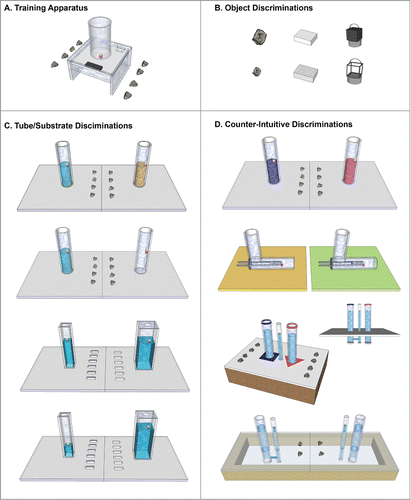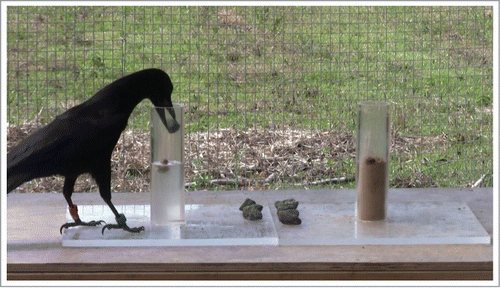Figures & data
Figure 1. Diagrams of the experimental apparatus used for different Aesop's Fable tasks listed in . (A) Training apparatus, used in:Citation2,4,5 stones dropped into the tube would collapse the central baited platform. (B) (l-r) large vs small stones; sinking vs floating objects: made of rubber and polystyrene, respectively; and solid vs hollow objects. (C) (top-bottom) water vs sand; water vs air; narrow vs wide tubes: with equal water levels; and narrow vs wide tubes: with unequal water levels. (D) (top-bottom) blue vs red woodchips: the reward was provided by the experimenter after a certain number of stones were dropped into one tube; L-shape apparatus: the reward was moved incrementally closer each time a stone was dropped into one apparatus; U-tube apparatus: stones dropped into the connected tube would also raise the water level in the central baited tube, but the connection was concealed; Uncovered U-tube: as before, but the connection between 2 of the tubes was visible. Logan et al.Citation5 used pairs of narrow and wide tubes for the covered U-tube, as well as the uncovered U-tube (pictured), instead of a U-tube with 3 tubes (as used inCitation2,4,6). Some diagrams are reproduced from Jelbert et al.Citation4

Figure 2. New Caledonian crow attempting the water vs. sand task. (in Jelbert et al.,Citation4 photo credit SJ).

Table 1 Summary of performance on the different Aesop's fable tasks used to investigate causal understanding in corvids and children
